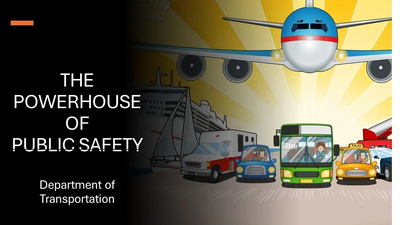Signed in as:
filler@godaddy.com
Signed in as:
filler@godaddy.com

The United States Department of Transportation, an executive department of the U.S. federal government, is led by the Secretary of Transportation, who reports directly to the President of the United States and is part of the President's Cabinet. The department aims to develop and coordinate policies that will provide efficient and economical national transportation system, with due regard for need, the environment, and national defense. It is also responsible for planning and coordinating federal transportation projects and establishing safety regulations for all major transportation modes. Agencies under the USDOT are:

The FAA delivers the world's safest, most efficient aerospace system. And
manages drug and alcohol testing for employers and employees in the aviation industry. You can find details on their web page.

The Federal Motor Carrier Safety Administration (FMCSA) aims to decrease crashes, injuries, and fatalities involving large trucks and buses. It was established as a separate administration within the U.S. Department of Transportation (DOT) on January 1, 2000, under the Motor Carrier Safety Improvement Act of 1999. FMCSA is headquartered in Washington, DC, and employs over 1,000 people across all 50 States and the District of Columbia, all dedicated to improving the safety of commercial motor vehicles (CMVs) and saving lives. The administration also regulates carriers and commercial driver's license holders (CDL). For FMCSA-related information, please visit their website.

The Federal Railroad Administration (FRA) was established by the Department of Transportation Act of 1966. It is one of ten U.S. Department of Transportation agencies focused on intermodal transportation. The FRA's mission is to facilitate the safe, reliable, and efficient transportation of people and goods crucial to growing a strong America, both now and in the future. Itsits motto is RAIL—Moving America Forward. For further information, please visit their website.

The Federal Transit Administration (FTA) aims to enhance American communities through public transportation. Its goal is to create a better quality of life for everyone by striving for public transportation excellence—the FTA's shape how we achieve our mission. We uphold a culture of service, integrity, innovation, sustainability, and equity as we implement our policies, programs, and initiatives and support the nation's transit systems. The Federal Transit Administration (FTA) provides safety resources and oversight for the mass transit industry. You can find more information on their official website.

The administration also oversees pipeline industry operators and employees. For PHMSA-related information, visit the PHMSA website.

The mission of the USCG is to ensure our Nation’s maritime safety, security, and stewardship.
The USCG accomplishes this through six major operational mission programs:
Maritime Law Enforcement, Maritime Response, Maritime Prevention, Marine Transportation System Management, Maritime Security Operations, and Defense Operations. Although, USG adhere to Part 40 for drugs but not for alcohol. To find out more, go to the United States Coast Guard (uscg.mil)

The FMCSA Commercial Driver’s License Drug and Alcohol Clearinghouse maintains records of all drug and alcohol program violations by commercial drivers, including those with a commercial driver’s license (CDL) or a commercial learner’s permit (CLP). The primary objective is to ensure thaThe FMCSA Commercial Driver's License Drug and Alcohol Clearinghouse maintains records of all drug and alcohol program violations by commercial drivers, including those with a commercial driver's license (CDL) or a commercial learner's permit (CLP). The main goal is to ensure that these drivers undergo the necessary evaluations, education, or treatment before they can resume safety-sensitive functions, such as operating a commercial motor vehicle. This initiative is aimed at improving roadway safety. Every driver must be registered on the Clearinghouse. The Return to Duty process begin by you including your designated Substance Abuse Professional (SAP) on your Clearinghouse record.
The Department of Transportation (DOT) strictly enforces regulations regarding drug and alcohol use for safety-sensitive employees. ISSLC’s Substance Abuse Professional (SAP) is specially trained and qualified to guide employers and employees through the compliance process.
If an employee receives a confirmed violation—most commonly a positive test for alcohol or illicit drugs—they must immediately stand down from safety-sensitive duties. They cannot resume these duties until they have successfully completed the DOT return-to-duty process under the supervision of a qualified SAP.
Here’s how the process works:
ISSLC is committed to swift and professional support. We begin working with your employee within 24 hours of receiving your call.
Please follow the above steps carefully to ensure a smooth and compliant return to work.


We use cookies to analyze website traffic and optimize your website experience. By accepting our use of cookies, your data will be aggregated with all other user data.